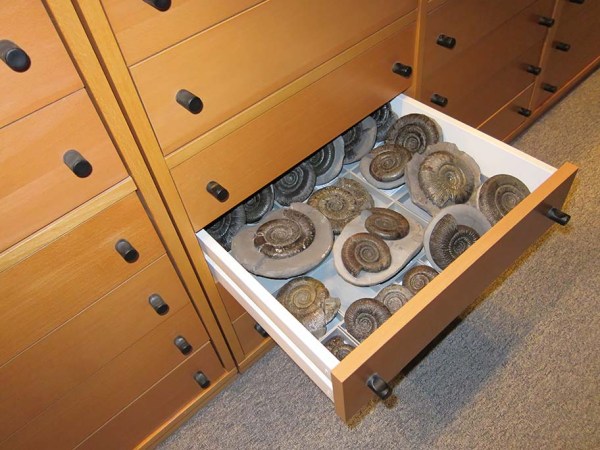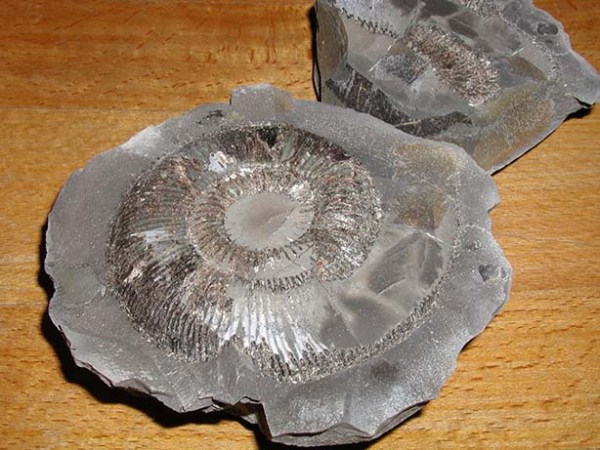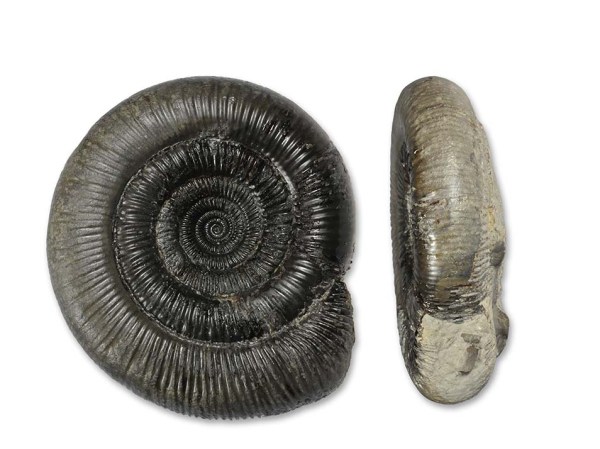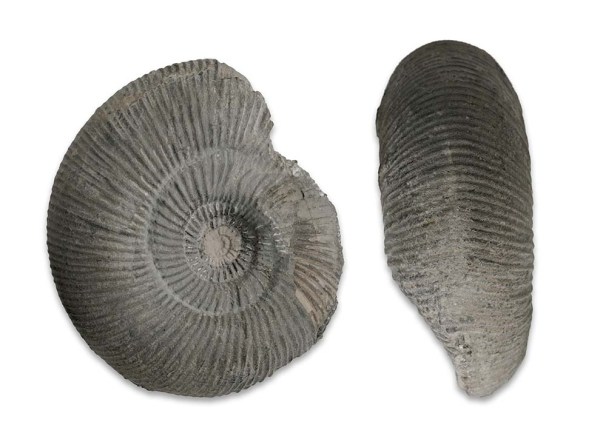
Drawer with various Dactylioceras (Orthodactylites) sp.
One of the most collected and most left behind, most loved and most hated ammonites of the Yorkshire lias must be the genus Dactylioceras, also known as the “common Dac”. It is indeed one of the most common ammonites, at least at genus level, the seas of toarcian times must have been teeming with these animals, considering that what we find today is probably only the small fraction that made it to preservation.
In the 1970s to 1990s there have been heated scientific discussions on the classification of the Dactylioceratidae e.g. between HOWARTH and GUEX.
The following articles follow the publications by M.K. Howarth who in my humble opinion provided a framework for classification grounded in solid stratigraphy and
statistics that is very consistent to what can be observed on the Yorkshire coast.
This is the first part of what will most probably become a multipart post showing the surprising variety, and exploring the difficulty in identification of these fossils that comes with it…
Here I will cover the Grey Shales species
Dactylioceras (Orthodactylites) semicelatum (SIMPSON)
Dactylioceras (Orthodactylites) tenuicostatum (YOUNG & BIRD)
Dactylioceras (Orthodactylites) clevelandicum HOWARTH
Dactylioceras (Orthodactylites) crosbeyi (SIMPSON)
With a little care when splitting the nodules (and taking the negative with you for a transfer of torn off whorl sections if need be) ,
a lot of the specimen can be preserved with intact mouth borders. When I do find these nodules nowadays, I tend to just
carefully investigate if an ammonite is present in the nodule without splitting the nodule horizontally which raises the rate of success
in preserving the ammonite in its entirety.

Dacytlioceras (O.) semicelatum nodule, as found, with the negative taken home as well
Dactylioceras (Orthodactylites) semicelatum (SIMPSON)

Dactylioceras (Orthodactylites) semicelatum, coronate form, 7 cm, from Yorkshire Coast Fossils

Dactylioceras (O.) semicelatum, thick form, with coronate inner whorls, 9 cm

Dactylioceras (O.) semicelatum, slender form, 8 cm
Dactylioceras (Orthodactylites) semicelatum (SIMPSON) is the youngest of the group, found at the top of the Grey shales, beds 28 to 32 (HOWARTH 1973),
which of course corresponds to the semicelatum subzone of the lower toarcian.
The 3 specimen pictured above perfectly show what is amazing about this species : The amount of variation in the shell forms exhibited may lead a collector who looks at these 3 specimen in isolation to think these are different species, yet when viewed in the context of all the specimen found in the above mentioned beds (HOWARTH examined more than 100 specimen for his “Grey Shales” paper) , it becomes apparent that there is continuous variation between the different forms.
(If you read my blog very carefully, you might have noticed that I had previously labeled the coronate form of D. semicelatum as D. cf. crosbeyi – but after reading Howarth´s paper completely and discussing the
location of the find with Mike Marshall, I´ve come to the conclusion that it´s really a D. semicelatum)
Now that of course leads to the questions : What is a species ? When is a morphological difference enough to call it a different species ?
For living organisms this is much easier to answer than for fossils : “A species is often defined as a group of organisms capable of interbreeding and producing fertile offspring” (from Wikipedia http://en.wikipedia.org/wiki/Species). This is something that can be observed in the wild, today we even have genetics to measure the amount of differences in the genes. No such luck with fossils, we only have the rock and the impression and/or the petrified remains of the animal to judge from.
Thus the species definition for fossil material is not comparable to the biospecies definition, it is only based on morphological similarities, also called a morphospecies.
With a large enough population of fossils, you can quantify the variation in the fossils in measurements such as number of ribs / whorl @ diameter, whorl breadth, whorl height etc. (
see previous post ) as a statistical population variance. Comparing variances of different groups of fossils then helps to separate different morphospecies from each other. That brings us back to the semicelatum problem : When you find within that within a certain timeframe (a restricted number of beds) there is continuous variation of the fossil forms found within these beds, it is safe to assign it to the same species, then also called a chronospecies (see also Wikipedia
http://en.wikipedia.org/wiki/Chronospecies, and
http://www.mun.ca/biology/scarr/Evolutionary_vs_Chronospecies.htm )
But back to showing the practical differences for the collector :
To quote HOWARTH 1973 (it just hits the nail on the head, I just could not write it any better in a single sentence) :
“D. (O.) semicelatum is more involute and has higher whorls than either tenuicostatum or clevelandicum.” Ribs per whorl can vary from 45 to 80 at 70 mm diameter.
The typical semicelatum nodule usually has some pyrite content.
Dactylioceras (Orthodactylites) tenuicostatum (YOUNG & BIRD)

Dactylioceras (O.) tenuicostatum, 7.5 cm
The zonal ammonite Dactylioceras (Orthodactylites) tenuicostatum (YOUNG & BIRD) (beds 20-26) has a more round whorl section,
can have a lot more ribs/whorl (between 90 and 140 ! at 70 mm) than any of the other species
(allthough there is overlap at the bottom of the range, average ribs/whorl also increase from bed 20 to 22).
The largest specimen of D. tenuicostatum seem to be smaller than the largest specimen of D. semicelatum and D. clevelandicum.
tenuicostatum-nodules are usually a bit softer than semicelatum nodules.
Dactylioceras (Orthodactylites) clevelandicum HOWARTH

Dactylioceras (O.) clevelandicum, 9 cm
Dactylioceras (Orthodactylites) clevelandicum HOWARTH (bed 19b) is more similar to D. tenuicostatum than to D. semicelatum or D. crosbeyi in being more evolute and having a round whorl section (on the outer whorl), differences are mainly that D. clevelandicum has less ribs / whorl than D. tenuicostatum (70 at 70 mm for D. clevelandicum vs. about 100 for D. tenuicostatum) and much more robust inner whorls, usually with spines. The rate of growth in whorl breadth is higher than in D. tenuicostatum, thus the umbilicus looks deeper than in D. tenuicostatum and at same diameter, whorl breadth is greater i.e. the whorl is thicker.
Dactylioceras (Orthodactylites) crosbeyi (SIMPSON)

Dactylioceras (O.) crosbeyi, 8 cm, Mulroy collection
Dactylioceras (Orthodactylites) crosbeyi (SIMPSON) is the oldest ammonite of the group, occurring only in bed 18 of the Grey Shales.
It is a quite rare, most of the time preserved only fragmentary as body chamber with crushed inner whorls.
D. crosbeyi is similar in appearance to D. semicelatum, just slightly more involute, but whorls are a higher and a lot thicker, ribs /whorl (about 70 at 80mm) at are usually lower than on similarly sized D. semicelatum.
This first part covered the lower toarcian Dactylioceratidae that can be found on the Yorkshire coast. As you might have seen from the notes in which beds the ammonites can be found, for the lower toarcian “Dacs” it is sometimes helpful to know which bed they came from – for the upper toarcian “Dacs”, this is most of the times essential to be able to properly identify them.
The next post will not be Part II as the continuation of this one, I have another post waiting about pathological ammonites and the following picture is just the ideal transition:

Double nodule of D.(O.) tenuicostatum, one with pathology, both about 7 cm, purchased from Yorkshire Coast Fossils / Mike Marshall
AndyS
Literature : M.K. Howarth : The Stratigraphy and Ammonite Fauna of the Upper Liassic Grey Shales of the Yorkshire Coast.
Bulletin of The British Museum (Natural History), Geology series, Vol. 24 No 4. London 1973









